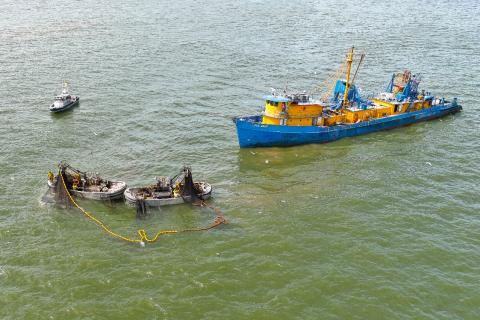The “Developing Methods to Observe Sea Turtle Interactions in the Gulf of Mexico Menhaden Purse Seine Fishery” project kicked off in 2020. Approved in the 2019 Open Ocean Restoration Plan 2, NOAA and fishing industry partners have completed the first steps in this important project—testing out observer methods in the field. Fishery observers are biological technicians collecting data, and tracking interactions with sea turtles and other animals in commercial fisheries.
The menhaden fishery utilizes large purse seine nets, deployed around schools of menhaden. Menhaden are small, but economically important fish used as an ingredient in pet food, aquaculture and livestock feeds, as well as fertilizers and commercial fishing bait.
Other fish and animals can be incidentally caught and entangled in the purse seine nets as they’re hauled in, potentially causing injuries or death. There isn’t a strong understanding of if and when sea turtles are caught, so this project focuses on:
- Developing methods to observe Gulf menhaden fishery operations to better understand sea turtle interactions
- Identifying opportunities for voluntary measures to avoid and reduce those interactions
Three Proposed Methods of Observation
Since 2020, NOAA has worked collaboratively with menhaden commercial fishing industry representatives to plan fieldwork to test different observation methods.
After planning, 5 days of fieldwork were completed in October 2021. Three observation methodologies were field tested for feasibility in the menhaden fishery:
- Human observers
- Electronic monitoring (stationary video cameras installed on the fishing vessel)
- Drones
Multiple combinations of these three observation methods were tested. The intent was to overlap as many methods and net deployments (fishing sets) as possible to determine the effectiveness and feasibility of each. Various sized sea turtle models were used as examples since the likelihood of encountering a real sea turtle during 5 days of fieldwork was low. All three methods tested were effective in detection of the models during net deployments in which they were used.
Observation Methods Report and Next Steps
The project team reviewed the reports of all methods tested during the fieldwork. The project steering committee discussed the results and NOAA made recommendations for observation methods to be used in a pilot phase of the project in the Proof of Concept Summary Report (PDF, 16 pages). The pilot phase is likely to take place in 2022, during the Gulf of Mexico menhaden fishing season, which lasts from mid-April to November 1.
Fishing Industry Collaboration
Collaboration is key to many projects in the Open Ocean restoration portfolio. In these initial and future phases, the project is relying on fishing industry partners’ stepping up to participate and collaborate. NOAA works with a steering committee of industry representatives to help guide the project. Purse seine fishing vessels and crews also volunteered their time to field test the methodologies, and will support the upcoming pilot phase.
NOAA and the other trustees are collaborating with both commercial and recreational fisheries to restore fish and sea turtle species injured by the 2010 Deepwater Horizon oil spill.


